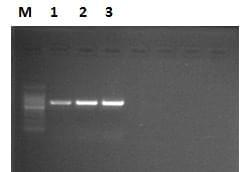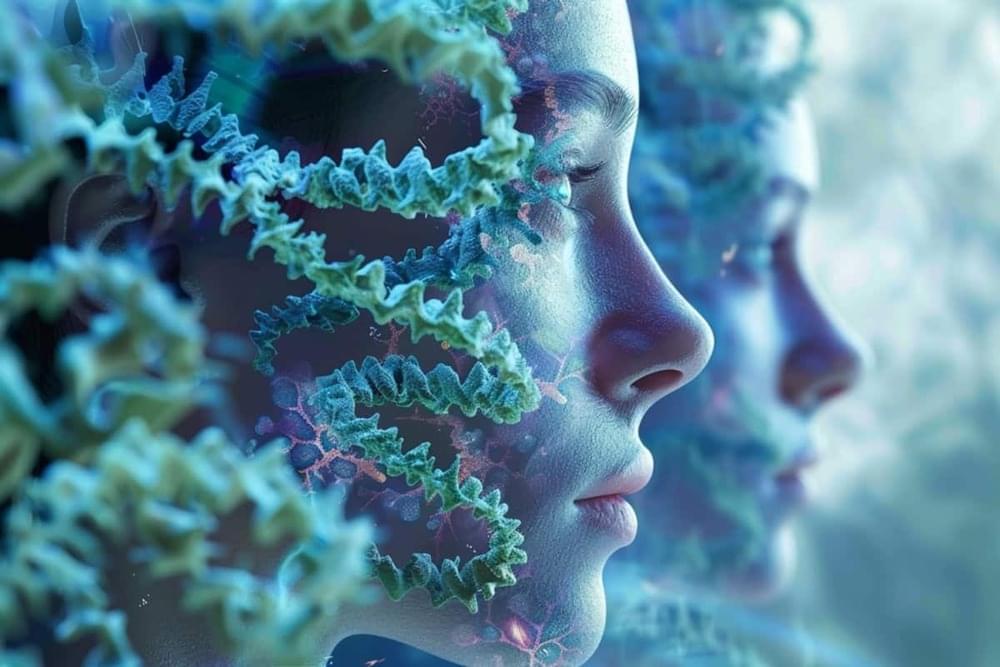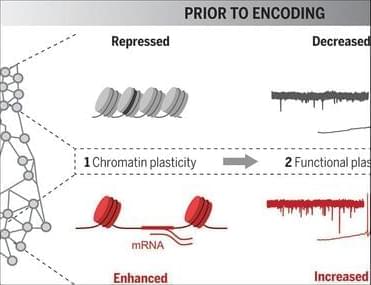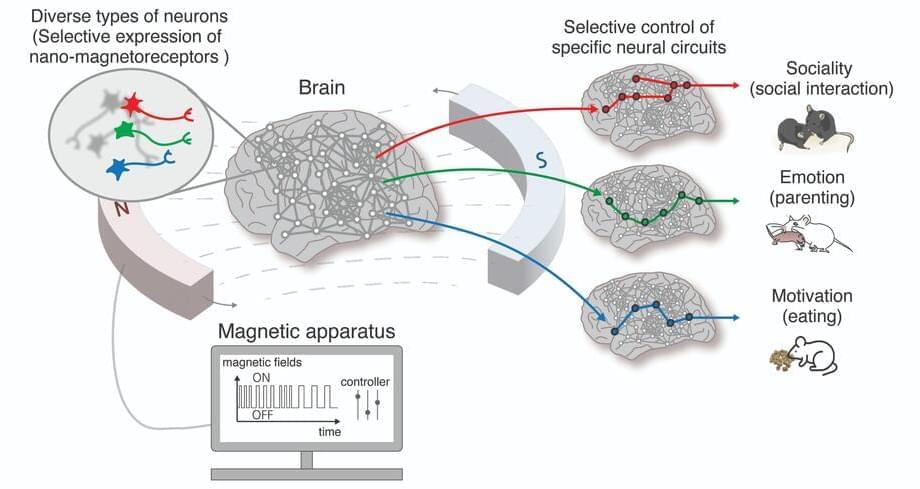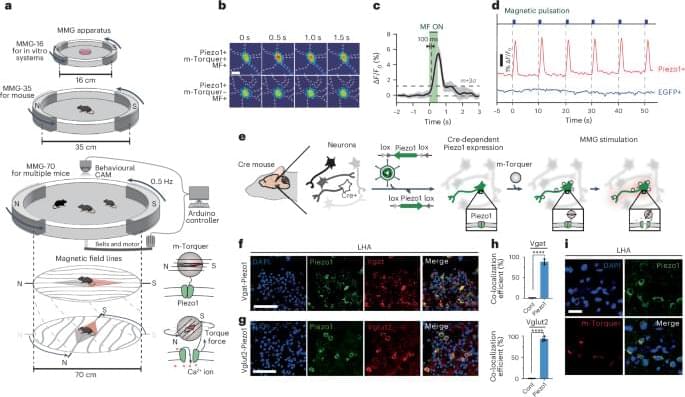Archive for the ‘genetics’ category: Page 30
Jul 30, 2024
Scientists ‘Mind Controlled’ Mice Remotely in Extraordinary World First
Posted by Shubham Ghosh Roy in categories: bioengineering, biotech/medical, genetics, nanotechnology, neuroscience
At the mere flick of a magnetic field, mice engineered with nanoparticle-activated ‘switches’ inside their brains were driven to feed, socialize, and act like clucky new mothers in an experiment designed to test an innovative research tool.
While ’mind control’ animal experiments are far from new, they have generally relied on cumbersome electrodes tethering the subject to an external system, which not only requires invasive surgery but also sets limits on how freely the test subject can move about.
In what is claimed to be a breakthrough in neurology, researchers from the Institute for Basic Science (IBS) in Korea have developed a method for targeting pathways in the brain using a combination of genetics, nanoparticles, and magnetic fields.
Jul 29, 2024
Mapping the Mechanisms of Aging
Posted by Shubham Ghosh Roy in categories: biological, genetics, life extension, mapping, neuroscience
Aging is a universal experience, evident through changes like wrinkles and graying hair. However, aging goes beyond the surface; it begins within our cells. Over time, our cells gradually lose their ability to perform essential functions, leading to a decline that affects every part of our bodies, from our cognitive abilities to our immune health.
To understand how cellular changes lead to age-related disorders, Calico scientists are using advanced RNA sequencing to map molecular changes in individual cells over time in the roundworm, C. elegans. Much like mapping networks of roads and landscapes, we’re charting the complexities of our biology. These atlases uncover cell characteristics, functions, and interactions, providing deeper insights into how our bodies age.
In the early 1990s, Cynthia Kenyon, Vice President of Aging Research at Calico, and her former team at UCSF discovered genes in C. elegans that control lifespan; these genes, which influence IGF1 signaling, function similarly to extend lifespan in many other organisms, including mammals. The genetic similarities between this tiny worm and more complex animals make it a useful model for studying the aging process. In work published in Cell Reports last year, our researchers created a detailed map of gene activity in every cell of the body of C. elegans throughout its development, providing a comprehensive blueprint of its cellular diversity and functions. They found that aging is an organized process, not merely random deterioration. Each cell type follows its own aging path, with many activating cell-specific protective gene expression pathways, and with some cell types aging faster than others. Even within the same cell type, the rate of aging can vary.
Jul 29, 2024
Epigenetics Unlocks Secrets of Memory Formation
Posted by Genevieve Klien in categories: genetics, neuroscience
Summary: A new study reveals that the epigenetic state of neurons determines their role in memory formation. Neurons with open chromatin states are more likely to be recruited into memory traces, showing higher electrical activity during learning.
Researchers demonstrated that manipulating these epigenetic states in mice can enhance or impair learning. This discovery shifts the focus from synaptic plasticity to nuclear processes, offering potential new avenues for treating cognitive disorders.
Jul 29, 2024
Controversial CRISPR scientist promises “no more gene-edited babies” until society comes around
Posted by Saúl Morales Rodriguéz in categories: biotech/medical, finance, genetics
In a public interview, Chinese biophysicist He Jiankui said he is receiving offers of financial support from figures in the US.
Jul 28, 2024
Chromatin plasticity predetermines neuronal eligibility for memory trace formation
Posted by Cecile G. Tamura in categories: genetics, robotics/AI
It is clear that specific memories are not stored in individual specific neurons.
But the epigenetic state of neurons influences whether they become part of memory…
Memories are encoded by sparse populations of neurons but how such sparsity arises remains largely unknown. We found that a neuron’s eligibility to be recruited into the memory trace depends on its epigenetic state prior to encoding. Principal neurons in the mouse lateral amygdala display intrinsic chromatin plasticity, which when experimentally elevated favors neuronal allocation into the encoding ensemble. Such chromatin plasticity occurred at genomic regions underlying synaptic plasticity and was accompanied by increased neuronal excitability in single neurons in real time. Lastly, optogenetic silencing of the epigenetically altered neurons prevented memory expression, revealing a cell-autonomous relationship between chromatin plasticity and memory trace formation. These results identify the epigenetic state of a neuron as a key factor enabling information encoding.
Jul 26, 2024
Unlock Gene Networks Using Limited Data with AI Model Geneformer
Posted by Shubham Ghosh Roy in categories: biotech/medical, genetics, robotics/AI
Geneformer is a recently introduced and powerful AI model that learns gene network dynamics and interactions using transfer learning from vast single-cell transcriptome data. This tool enables researchers to make accurate predictions about gene behavior and disease mechanisms even with limited data, accelerating drug target discovery and advancing understanding of complex genetic networks in various biological contexts.
Developed by researchers at the Broad Institute of MIT and Harvard and their collaborators, the AI model Geneformer uses the highest-expressed genes in sc-RNA expression data to generate a dense representation of each cell, which can be used as features for various downstream predictive tasks. What makes Geneformer unique, however, are the capabilities its architecture enables, even when trained on very little data.
Geneformer has a BERT-like transformer architecture and was pre-trained on data from about 30M single-cell transcriptomes across various human tissues. Its attention mechanism enables it to focus on the most relevant parts of the input data. With this context-aware approach, the model can make predictions by considering relationships and dependencies between genes.
Jul 26, 2024
New Technology to Control the Brain Using Magnetic Fields Developed
Posted by Saúl Morales Rodriguéz in categories: biotech/medical, computing, genetics, nanotechnology, neuroscience
Nano-MIND Technology for Wireless Control of Brain Circuits with Potential to Modulate Emotions, Social Behaviors, and Appetite.
Researchers at the Center for Nanomedicine within the Institute for Basic Science (IBS) and Yonsei University in South Korea have unveiled a groundbreaking technology that can manipulate specific regions of the brain using magnetic fields, potentially unlocking the secrets of high-level brain functions such as cognition, emotion, and motivation. The team has developed the world’s first Nano-MIND (Magnetogenetic Interface for NeuroDynamics) technology, which allows for wireless, remote, and precise modulation of specific deep brain neural circuits using magnetism.
The human brain contains over 100 billion neurons interconnected in a complex network. Controlling the neural circuits is crucial for understanding higher brain functions like cognition, emotion, and social behavior, as well as identifying the causes of various brain disorders. Novel technology to control brain functions also has implications for advancing brain-computer interfaces (BCIs), such as those being developed by Neuralink, which aim to enable control of external devices through thought alone.
Continue reading “New Technology to Control the Brain Using Magnetic Fields Developed” »
Jul 25, 2024
In vivo magnetogenetics for cell-type-specific targeting and modulation of brain circuits
Posted by Logan Thrasher Collins in categories: biotech/medical, genetics, nanotechnology, neuroscience
Minimally invasive cellular-level target-specific neuromodulation is needed to decipher brain function and neural circuitry. Here nano-magnetogenetics using magnetic force actuating nanoparticles has been reported, enabling wireless and remote stimulation of targeted deep brain neurons in freely behaving animals.
Jul 25, 2024
Evolution May Be Purposeful And It’s Freaking Scientists Out
Posted by Dan Breeden in categories: biotech/medical, computing, genetics
Teleology the return of Aristotle?
The scientific story of who we are is a reductionist, gene-centric model that forfeits natural phenomena like purpose due to its association with intelligent design and a transcendent, intelligent designer. Noble is neutral on religious matters. Yet he sees compelling evidence that purpose may be fundamental to life. He’s determined to debunk the current scientific paradigm and replace the elevated importance of genes with something much more controversial. His efforts have enraged many of his peers but gained support from the next generation of origins-of-life researchers working to topple the reign of gene-centrism. If successful, the shift could not only transform how we classify, study and treat disease, but what it means to be alive.
One of the earliest biomedical computer programmers, Noble created the first model for a working human heart in 1960 on a vacuum tube computer. The project led to his discovery that heartbeats are emergent properties—new phenomena—arising from feedback loops, transforming our understanding of heart function and underpin treatments for heart conditions that we use today. His research on the heart’s pacemaker demonstrates a prioritization of the organism as a whole over its genes alone. “Several genes could individually be knocked out but the process continues,” says Noble. These genes are responsible for heart rhythm, yet other mechanisms can take over to get the job done.
Continue reading “Evolution May Be Purposeful And It’s Freaking Scientists Out” »
